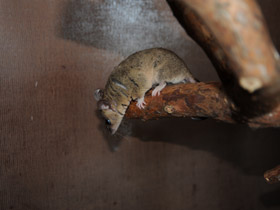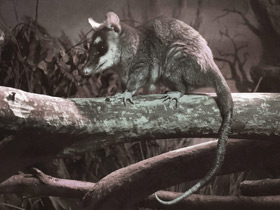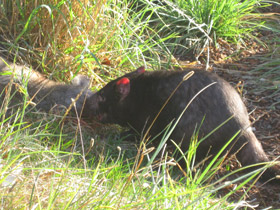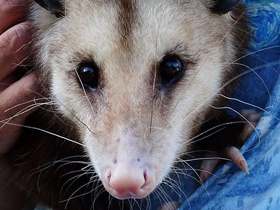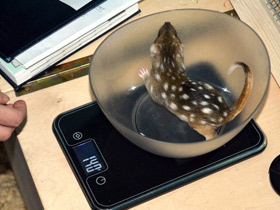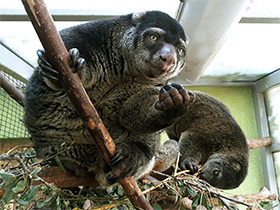The mammalian infraclass Marsupialia (Marsupials)
Marsupials are any members of the mammalian infraclass Marsupialia. All extant marsupials are endemic to Australasia, Wallacea and the Americas. A distinctive characteristic common to most of these species is that the young are carried in a pouch. Living marsupials include kangaroos, koalas, opossums, Tasmanian devils, wombats, wallabies, and bandicoots among others, while many extinct species, such as the thylacine, Thylacoleo, and Diprotodon, are also known.
Marsupials represent the clade originating from the last common ancestor of extant metatherians, the group containing all mammals more closely related to marsupials than to placentals. Placentals and marsupials diverged from each other at least 125 million years ago, and possibly over 160 million years ago, during the Middle Jurassic-Early Cretaceous. Marsupials give birth to relatively undeveloped young that often reside in a pouch located on their mothers' abdomen for a certain amount of time. Close to 70% of the 334 extant species occur on the Australian continent (the mainland, Tasmania, New Guinea and nearby islands). The remaining 30% are found in the Americas—primarily in South America, thirteen in Central America, and one species, the Virginia opossum, in North America, north of Mexico.
The word marsupial comes from marsupium, the technical term for the abdominal pouch. It, in turn, is borrowed from the Latin marsupium and ultimately from the ancient Greek μάρσιππος mársippos, meaning "pouch".
Description and distribution
Marsupialia are an infraclass of metatherian mammals. They are characterised by a short in utero development and complete much of their growth clinging to the mammary glands inside the marsupial pouch or marsupium. There are about two hundred and seventy extant species, about seventy in the Americas and approximately two hundred in Australia. In some species the marsupium is too small to carry all their young.
Marsupials are a vast group of mammals with many ancient and primitive characteristics that distinguish them from placental or higher animals. Many zoologists consider marsupials to be an infraclass. Most Marsupialia are distributed in Australia, New Guinea and nearby islands. This infraclass includes species that do not resemble each other in appearance, body structure or way of life. They range from peaceful herbivores such as kangaroos and koalas, to insectivores such as marsupials and wambats, to ferocious predators such as the Tasmanian devil, capable of taking on a medium-sized kangaroo.
The size variations are also impressive: from 10 cm in the Kimberley mouse marsupial to 3 m in the giant grey kangaroo. But all Marsupialia have one thing in common: they give birth to small, undersized offspring, which the females carry in their brood pouch for a long time. Incidentally, most Marsupialia have a pouch, but not all of them are developed to the same degree; some species have only a small fold that limits the milk field.
Body temperature
Marsupials, along with monotremes (platypuses and echidnas), typically have lower body temperatures than similarly sized placental mammals (eutherians), with the averages being 35 °C (95 °F) for marsupials and 37 °C (99 °F) for placental mammals. Some species will bask to conserve energy.
Reproduction
Gestation length in Marsupialia is very short, especially in primitive forms (e.g., opossums or marsupial cats 8-14 days, koala 35 days and kangaroo 38-40 days).
The different species give birth to one to 25 tiny, naked young: the largest member of the genus, the large grey kangaroo, has a newborn calf measuring only 25 mm; the primitive insect-eaters have a calf length of 7 mm and weigh between 0.6 and 5.5 g. To attach to the nipple, they have a nipple that can be attached to the nipple.
To attach itself to the nipple, the young must first reach the pouch and embark on a perilous journey over its mother's body. It moves with its clawed front legs, wriggling like a worm and clinging tightly to the female's fur, a journey that takes 5 to 30 minutes. Once the pouch is found, the calf immediately climbs inside, finds the nipple and attaches itself to it, so that it is almost impossible to pull it out. The baby does not suck the milk, but receives it passively in separate portions, and the amount of milk is regulated by the mother with the help of a special muscular contraction.
The baby grows rapidly and after a few weeks begins to detach from the nipple and to pull its head out of the pouch. At first the mother does not allow it to come out by adjusting the size of the pouch outlet.
The young of the various marsupial species spend several weeks to several months in the pouch, but even when they mature, they are far from leaving it for good. Kangaroos, for example, can be seen making brief forays and then returning to the pouch to eat and rest. It is not uncommon for a female to have offspring of three ages at once: the eldest has already adapted to independent living but prefers to spend time in the mother's pouch, the middle one is not yet off the teat and the youngest is not yet born.
Taxonomy
Marsupials are taxonomically identified as members of mammalian infraclass Marsupialia, first described as a family under the order Pollicata by German zoologist Johann Karl Wilhelm Illiger in his 1811 work Prodromus Systematis Mammalium et Avium. However, James Rennie, author of The Natural History of Monkeys, Opossums and Lemurs (1838), pointed out that the placement of five different groups of mammals – monkeys, lemurs, tarsiers, aye-ayes and marsupials (with the exception of kangaroos, that were placed under the order Salientia) – under a single order (Pollicata) did not appear to have a strong justification. In 1816, French zoologist George Cuvier classified all marsupials under the order Marsupialia. In 1997, researcher J. A. W. Kirsch and others accorded infraclass rank to Marsupialia.
Classification
Marsupialia is further divided as follows: † – Extinct:
- Superorder Ameridelphia (American marsupials):
- Order Didelphimorphia (93 species) – see list of didelphimorphs:
- Family Didelphidae: opossums;
- Order Paucituberculata (seven species):
- Family Caenolestidae: shrew opossums;
- Superorder Australidelphia (Australian marsupials):
- Order Microbiotheria (one extant species):
- Family Microbiotheriidae: monitos del monte;
- Order †Yalkaparidontia (incertae sedis);
- Grandorder Agreodontia:
- Order Dasyuromorphia (73 species) – see list of dasyuromorphs:
- Family †Thylacinidae: thylacine;
- Family Dasyuridae: antechinuses, quolls, dunnarts, Tasmanian devil, and relatives;
- Family Myrmecobiidae: numbat;
- Order Notoryctemorphia (two species):
- Family Notoryctidae: marsupial moles;
- Order Peramelemorphia (27 species):
- Family Thylacomyidae: bilbies;
- Family †Chaeropodidae: pig-footed bandicoots;
- Family Peramelidae: bandicoots and allies;
- Order Diprotodontia (136 species) – see list of diprotodonts;
- Suborder Vombatiformes:
- Family Vombatidae: wombats;
- Family Phascolarctidae: koalas;
- Family † Diprotodontidae: giant wombats;
- Family † Palorchestidae: marsupial tapirs;
- Family † Thylacoleonidae: marsupial lions;
- Suborder Phalangerida:
- Infraorder Phalangeriformes – see list of phalangeriformes:
- Family Acrobatidae: feathertail glider and feather-tailed possum;
- Family Burramyidae: pygmy possums;
- Family †Ektopodontidae: sprite possums;
- Family Petauridae: striped possum, Leadbeater's possum, yellow-bellied glider, sugar glider, mahogany glider, squirrel glider;
- Family Phalangeridae: brushtail possums and cuscuses;
- Family Pseudocheiridae: ringtailed possums and relatives;
- Family Tarsipedidae: honey possum;
- Infraorder Macropodiformes – see list of macropodiformes:
- Family Macropodidae: kangaroos, wallabies, and relatives;
- Family Potoroidae: potoroos, rat kangaroos, bettongs;
- Family Hypsiprymnodontidae: musky rat-kangaroo;
- Family † Balbaridae: basal quadrupedal kangaroos.


















